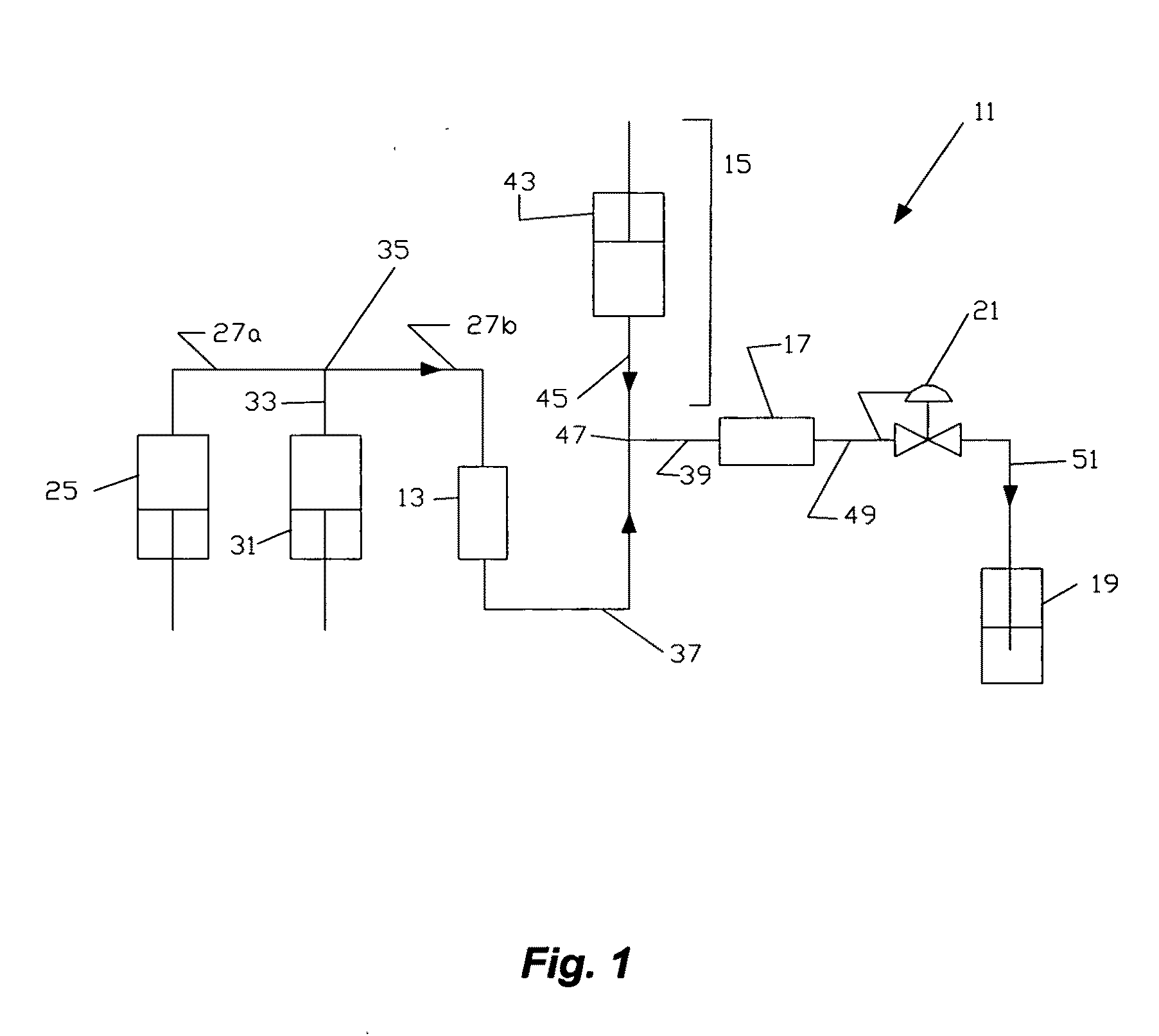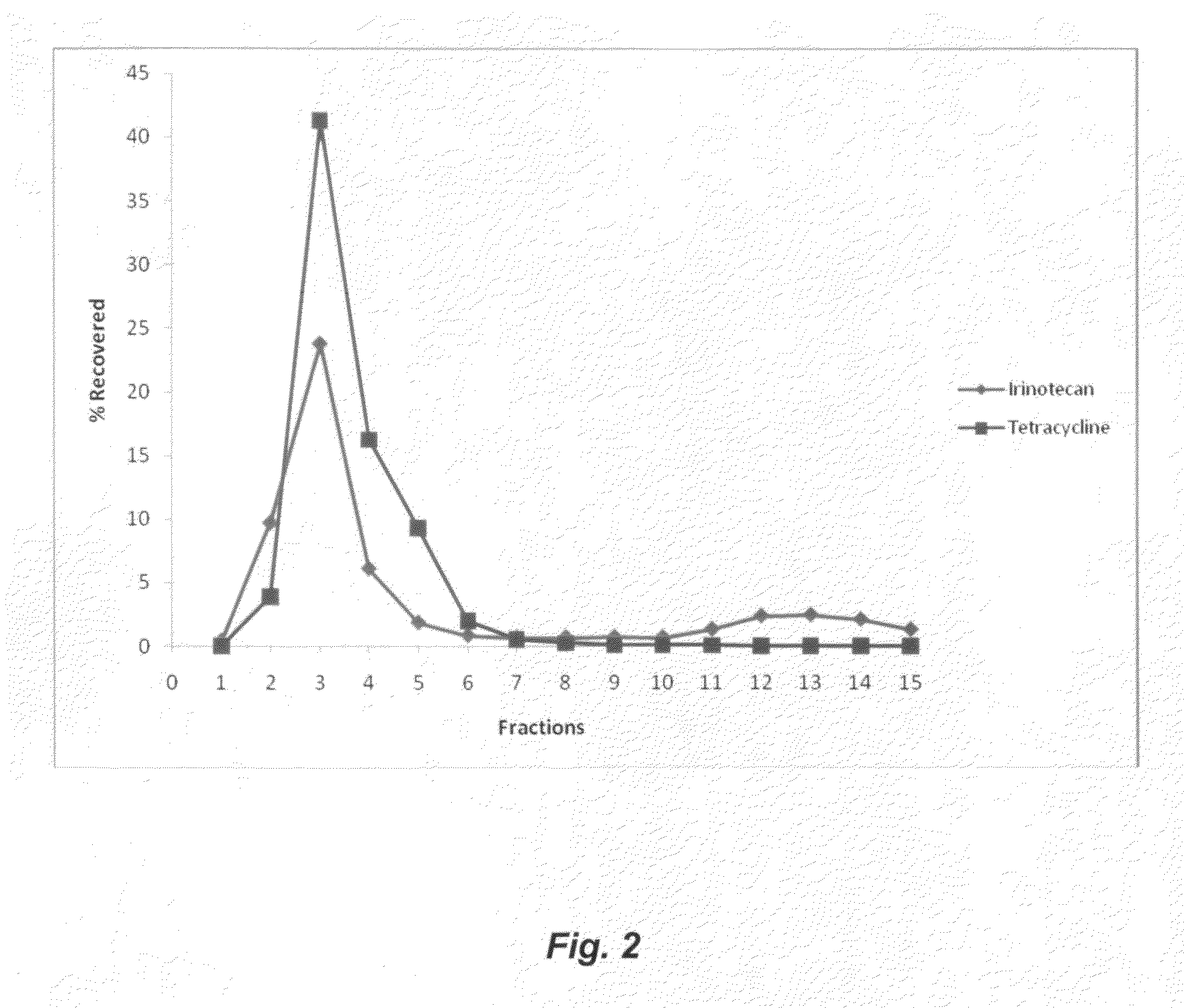Methods for co-encapsulation of combination drugs and co-encapsulated combination drug product
a combination drug and co-encapsulation technology, applied in the direction of medical preparations, antineoplastic agents, pharmaceutical delivery mechanisms, etc., can solve the problems of inability to readily co-encapsulate hydrophobic and hydrophilic, deficient 3′-phosphoglycolate processing of scan1 cells, low viability, etc., to reduce processing steps, time and preparation costs
- Summary
- Abstract
- Description
- Claims
- Application Information
AI Technical Summary
Benefits of technology
Problems solved by technology
Method used
Image
Examples
example 1
Co-Encapsulation of Camptothecin and Neomycin (TDP-10)
[0037]TDP-10 was conducted to encapsulate both camptothecin in the lipid bilayer and neomycin in the aqueous core. TDP-10 was performed with SFS propane and 20% ethanol at 3,000 psig and 40° C. in the phospholipid nanosomes apparatus shown in FIG. 1, with a 0.030″ injector and 150.0 mL mixing chamber.
[0038]In TDP-10, the operational and collection procedures were as follows: circulation time for 20 minutes, then depressurization from ˜3,000 psig to atmospheric pressure (0 psig). This operation was repeated twice. Each of the three fractions was collected into 50 mL of 10% sucrose solution at a temperature of 5° C.
[0039]The TDP-10 samples were first checked by HPLC for content of camptothecin (CPT) and neomycin, and particle size was measured utilizing a Coulter 4MND sub-micron particle size analyzer. Results for TDP-10 are listed in Table1.
TABLE 1Camptothecin Content and Size of TDP-10 Phospholipid NanosomesAmount of CPTAmount of...
example 2
Co-Encapsulation of Irinotecan and Tetracycline (TDP-12)
[0040]TDP-12 was conducted to encapsulate both irinotecan in the lipid bilayer and tetracycline in the aqueous core. TDP-12 was performed under similar conditions to TDP-10. These conditions were SFS propane with 20% ethanol at 3,000 psig and 40° C. in the SFS phospholipid nanosomes apparatus shown in FIG. 1, with a 0.030″ injector and 150.0 mL mixing chamber.
[0041]In TDP-12, the operational and collection procedures were as follows: circulation time for 20 minutes, then depressurization from ˜3,000 psig to atmospheric pressure (0 psig). This operation was repeated twice. Each of the three fractions was collected into 50 mL of 10% sucrose solution at a temperature of 5° C.
[0042]The TDP-12 samples were first checked by HPLC for content of irinotecan and tetracycline content, and particle size was measured utilizing a Coulter 4MND sub-micron particle size analyzer. Results for TDP-12 are listed in Table 2.
TABLE 2Irinotecan and Te...
example 3
TDP-12-01 Filtration
[0043]20 mL of a 75 mL sample of TDP-12-01 was filtered through a 0.1 μm polycarbonate filter using compressed N2. Between 40-50 psi was used for filtration to occur over about 15 hours. The 16 mL of filtrate collected was checked for irinotecan (Irino) and tetracycline (Tet) content and particle size. Results for the sterile filtration of TDP-12 are listed in Table 3.
TABLE 3Irinotecan and Tetracycline Content and Size of FilteredTDP-12-01 Phospholipid NanosomesTetIrinoMeanSample(mg / mL)(mg / mL)Diameter (nm)TDP-12-11.2780.201178TDP-12-11.2740.198544after 0.1 μmpolycarbonatefiltration
[0044]The sample TDP-12-1 that had been filtered allowed almost all of the Irino and tetracycline to pass through. The reduction of compound corresponds to the amount of sample lost (4 mL) during the filtration. The irinotecan and tetracycline did not appear to have degraded during this time frame. The particle size analysis of the filtrates indicates that the nanosomes were larger than...
PUM
| Property | Measurement | Unit |
|---|---|---|
| Temperature | aaaaa | aaaaa |
| Pressure | aaaaa | aaaaa |
| Diameter | aaaaa | aaaaa |
Abstract
Description
Claims
Application Information
 Login to View More
Login to View More - R&D
- Intellectual Property
- Life Sciences
- Materials
- Tech Scout
- Unparalleled Data Quality
- Higher Quality Content
- 60% Fewer Hallucinations
Browse by: Latest US Patents, China's latest patents, Technical Efficacy Thesaurus, Application Domain, Technology Topic, Popular Technical Reports.
© 2025 PatSnap. All rights reserved.Legal|Privacy policy|Modern Slavery Act Transparency Statement|Sitemap|About US| Contact US: help@patsnap.com


